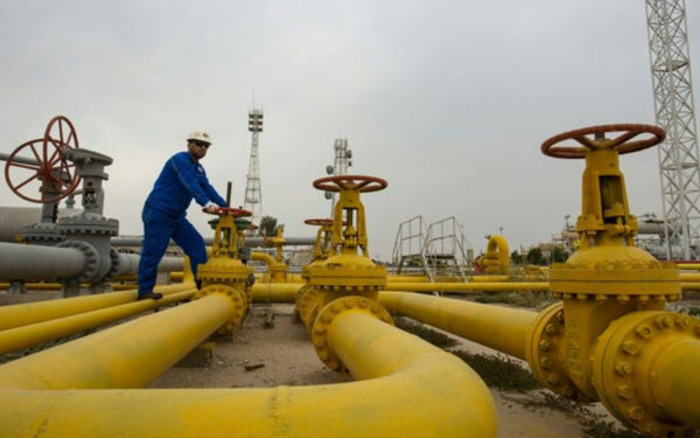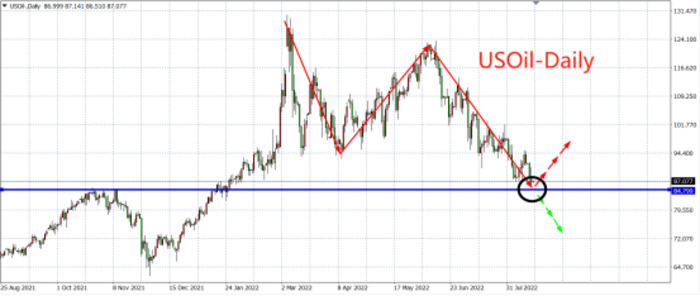Iran issue comes into focus
On Tuesday (August 16), WTI crude oil rebounded by 3% in intraday trading, but then fell more than 5% from a high of $90.63 to an intraday low of $85.74, hitting a new low for more than half a year and recording a three-day decline. The continued pressure on oil prices is mainly due to the slowdown in global economic growth under the accelerated tightening of monetary policies in various countries, which in turn weighs on energy demand. In addition, the uncertainty of the Iran nuclear deal also limits the market's willingness to further bullish oil prices.
There is no doubt that the market is currently focusing on the outcome of the Iran nuclear negotiations. If things go well, the parties to the Iran nuclear deal may reach a final agreement as early as a week later, which means that Iran is expected to increase production by about 100 tons within three months after the agreement is passed. 10,000 barrels per day, and could bring production close to its capacity saturation level of about 3.7 million barrels per day within six months, which will help ease market concerns about the European energy crisis.
At present, Iran and the United States have differences on three issues, but two of them have been verbally accepted by the United States. Iranian Foreign Minister Abdullahyan said on the 15th that Iran has shown enough flexibility, and it is the turn of the United States to show flexibility. However, on Tuesday (August 16), US State Department spokesman Price said at a briefing that Iran has been making demands unrelated to the resumption of the 2015 nuclear deal, including the lifting of its economic sanctions. Price said that reaching a final agreement depended on the attitude of the Iranian side and refused to accept demands beyond the scope of negotiations.
The author believes that although the current Iran nuclear deal is facing obstacles again, considering that the release of the US strategic oil reserves will be completed in October, and the US CPI in July fell due to the continuous decline in energy prices, the European energy crisis in winter may further increase. Therefore, it cannot be ruled out that the United States finally chooses to reach an agreement with Iran under a series of pressures.
It is worth noting that the EU's oil ban on Russia will take effect in December 2022, and the IEA said in its monthly report last week that Russia's oil production will fall by about 20% by the beginning of next year as the EU fully implements the ban in December. . Russia's July output reached nearly 10.8 million barrels per day.
Inflation-cutting bill released
In any case, the current crude oil market has not gotten rid of the downward trend since June. On the one hand, the Federal Reserve released a signal of further sharp interest rate hikes in September, and at the same time, it will accelerate the shrinking of its balance sheet in September, and the market liquidity shock continues to put pressure on oil prices.
On the other hand, the slowdown in the economic growth of China, the world's major oil digester, is a substantial drag on crude oil demand. Therefore, the current crude oil is facing certain pressures on both the supply and demand sides, and there is a possibility of further decline in the market outlook. Investors should especially pay attention to the gains and losses at the $85.0 level.
It is worth mentioning that U.S. President Joe Biden on Tuesday (August 16) signed the $750 billion Inflation Reduction Act of 2022, which includes addressing climate change and expanding health care. coverage, etc. The legislation allocates $369 billion for energy security and climate investments and aims to reduce carbon emissions by 40 percent by 2030. This means that the further increase in shale oil production space is limited.
To sum up, with the end of the release of the US Strategic Petroleum Reserve, the dominance of the crude oil market has gradually shifted to OPEC producers. OPEC only slightly increased production by 100,000 barrels per day in September, suggesting that oil prices will remain high for a longer time or OPEC hopes to see to the situation. In the short term, investors can pay attention to the minutes of the Fed's July meeting released on Thursday (August 18) and the Jackson Hole annual meeting released on August 25. Clues about the Fed's monetary policy in the second half of the year are expected to affect the trend of oil prices.
Oil prices face key support
U.S. oil has maintained a downward trend since June, and is about to hit the mid-term support of $85. Considering the recent frequent occurrence of major events in the oil market and the approaching of key nodes, this level is a watershed for long and short positions. Once the oil price can effectively stabilize at US$85, the market is expected to rebound and return to US$100. If it breaks below US$85, the shorts will strengthen. Continue to see US$80-76 below.
 2022-08-17
2022-08-17
 1358
1358







 简体中文
简体中文
 ภาษาไทย
ภาษาไทย
 繁體中文
繁體中文
 Indonesia
Indonesia











